IKEA's Expatriate Management: A Report on China and Australia
VerifiedAdded on 2021/06/17
|12
|3729
|125
Report
AI Summary
This report provides a literature review of IKEA's international human resource management (IHRM) practices, particularly focusing on expatriate management in China and Australia. It examines IKEA's operations, corporate strategies, and workforce management, highlighting the need for improved expatriation practices in these markets. The report explores the complexities of operating in diverse cultural contexts and the challenges of balancing global standardization with localized practices. The analysis covers three key aspects of expatriate management: sourcing, development, and performance management. It discusses workforce planning, recruitment, and selection processes, as well as the importance of training and development, including hard and soft skills. The report also addresses performance management strategies, considering cultural nuances and potential biases. The findings emphasize the challenges faced by IKEA in China compared to Australia, particularly in workforce management, store formats, and marketing activities. The report concludes with recommendations for enhancing IKEA's IHRM practices to ensure successful and sustainable business operations in both countries.
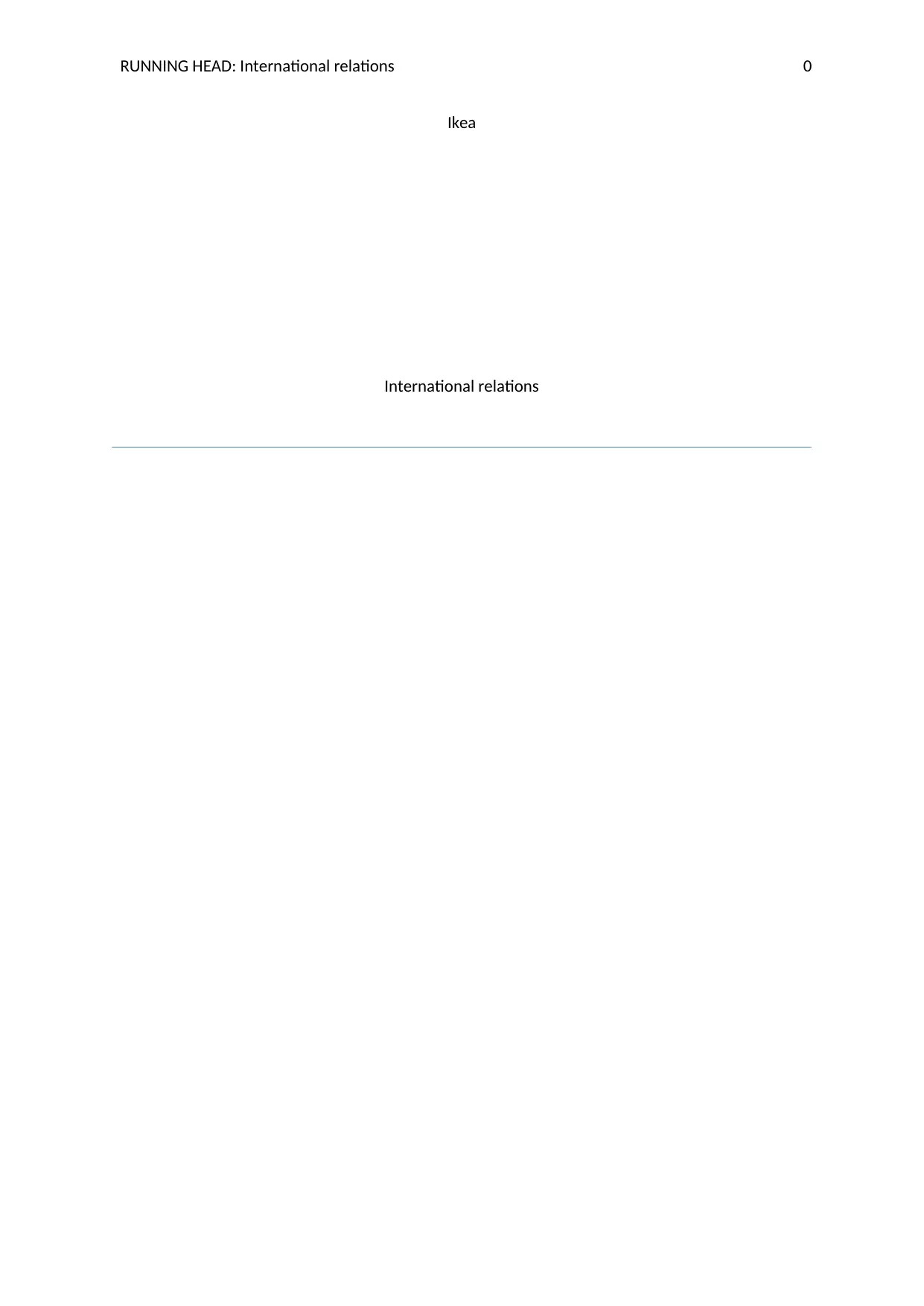
RUNNING HEAD: International relations 0
Ikea
International relations
Ikea
International relations
Paraphrase This Document
Need a fresh take? Get an instant paraphrase of this document with our AI Paraphraser
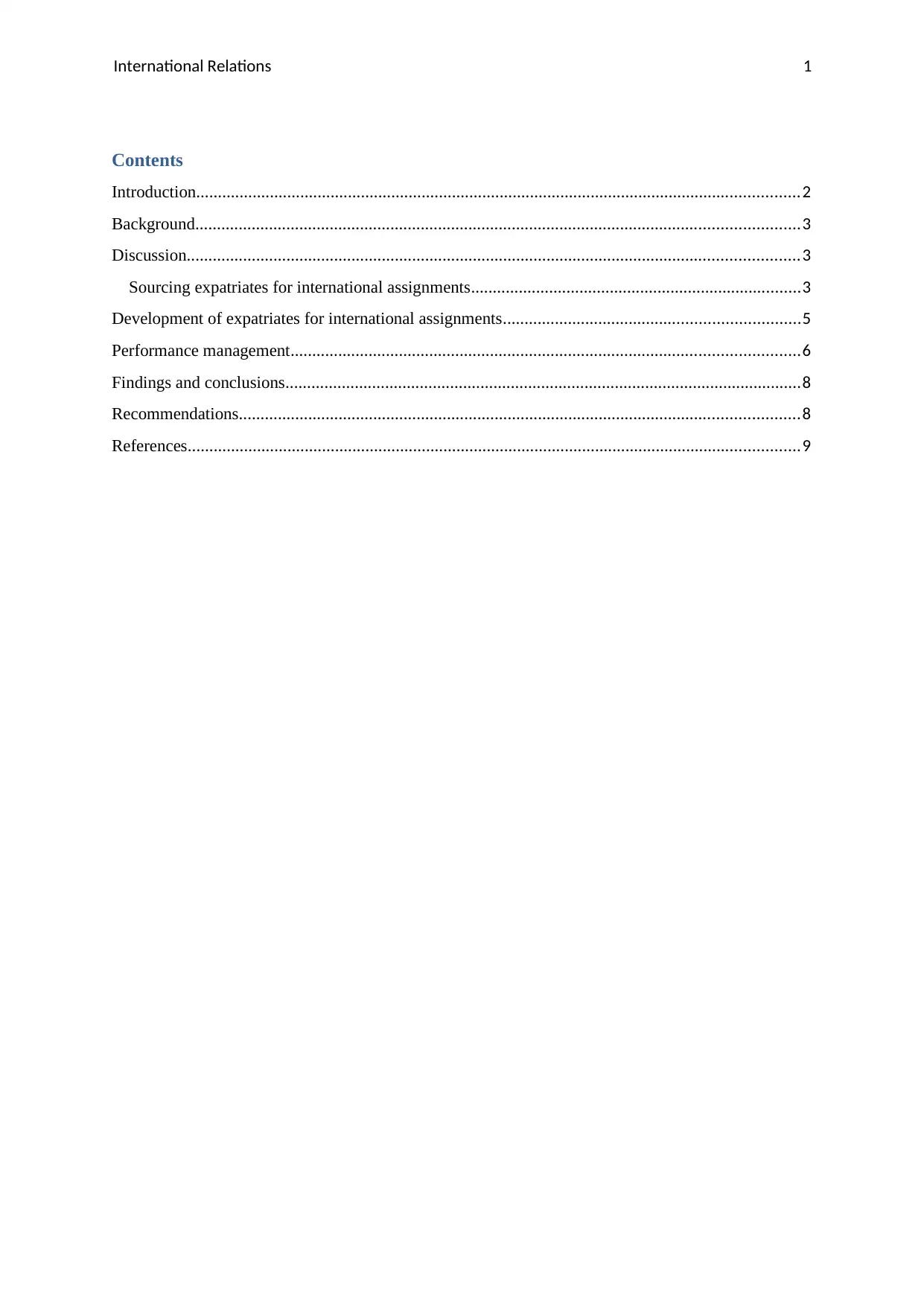
International Relations 1
Contents
Introduction...........................................................................................................................................2
Background...........................................................................................................................................3
Discussion.............................................................................................................................................3
Sourcing expatriates for international assignments............................................................................3
Development of expatriates for international assignments....................................................................5
Performance management.....................................................................................................................6
Findings and conclusions.......................................................................................................................8
Recommendations.................................................................................................................................8
References.............................................................................................................................................9
Contents
Introduction...........................................................................................................................................2
Background...........................................................................................................................................3
Discussion.............................................................................................................................................3
Sourcing expatriates for international assignments............................................................................3
Development of expatriates for international assignments....................................................................5
Performance management.....................................................................................................................6
Findings and conclusions.......................................................................................................................8
Recommendations.................................................................................................................................8
References.............................................................................................................................................9
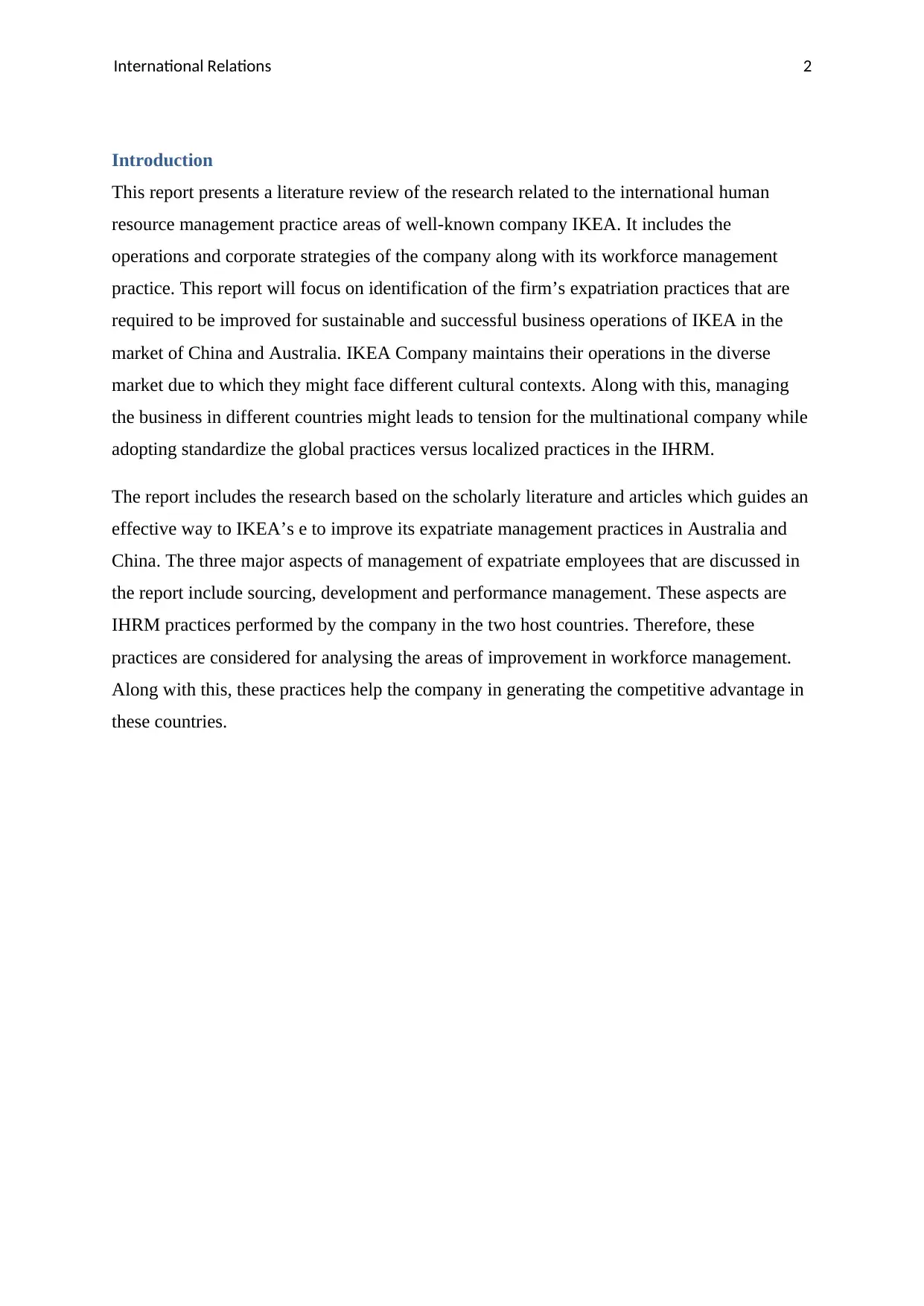
International Relations 2
Introduction
This report presents a literature review of the research related to the international human
resource management practice areas of well-known company IKEA. It includes the
operations and corporate strategies of the company along with its workforce management
practice. This report will focus on identification of the firm’s expatriation practices that are
required to be improved for sustainable and successful business operations of IKEA in the
market of China and Australia. IKEA Company maintains their operations in the diverse
market due to which they might face different cultural contexts. Along with this, managing
the business in different countries might leads to tension for the multinational company while
adopting standardize the global practices versus localized practices in the IHRM.
The report includes the research based on the scholarly literature and articles which guides an
effective way to IKEA’s e to improve its expatriate management practices in Australia and
China. The three major aspects of management of expatriate employees that are discussed in
the report include sourcing, development and performance management. These aspects are
IHRM practices performed by the company in the two host countries. Therefore, these
practices are considered for analysing the areas of improvement in workforce management.
Along with this, these practices help the company in generating the competitive advantage in
these countries.
Introduction
This report presents a literature review of the research related to the international human
resource management practice areas of well-known company IKEA. It includes the
operations and corporate strategies of the company along with its workforce management
practice. This report will focus on identification of the firm’s expatriation practices that are
required to be improved for sustainable and successful business operations of IKEA in the
market of China and Australia. IKEA Company maintains their operations in the diverse
market due to which they might face different cultural contexts. Along with this, managing
the business in different countries might leads to tension for the multinational company while
adopting standardize the global practices versus localized practices in the IHRM.
The report includes the research based on the scholarly literature and articles which guides an
effective way to IKEA’s e to improve its expatriate management practices in Australia and
China. The three major aspects of management of expatriate employees that are discussed in
the report include sourcing, development and performance management. These aspects are
IHRM practices performed by the company in the two host countries. Therefore, these
practices are considered for analysing the areas of improvement in workforce management.
Along with this, these practices help the company in generating the competitive advantage in
these countries.
⊘ This is a preview!⊘
Do you want full access?
Subscribe today to unlock all pages.

Trusted by 1+ million students worldwide
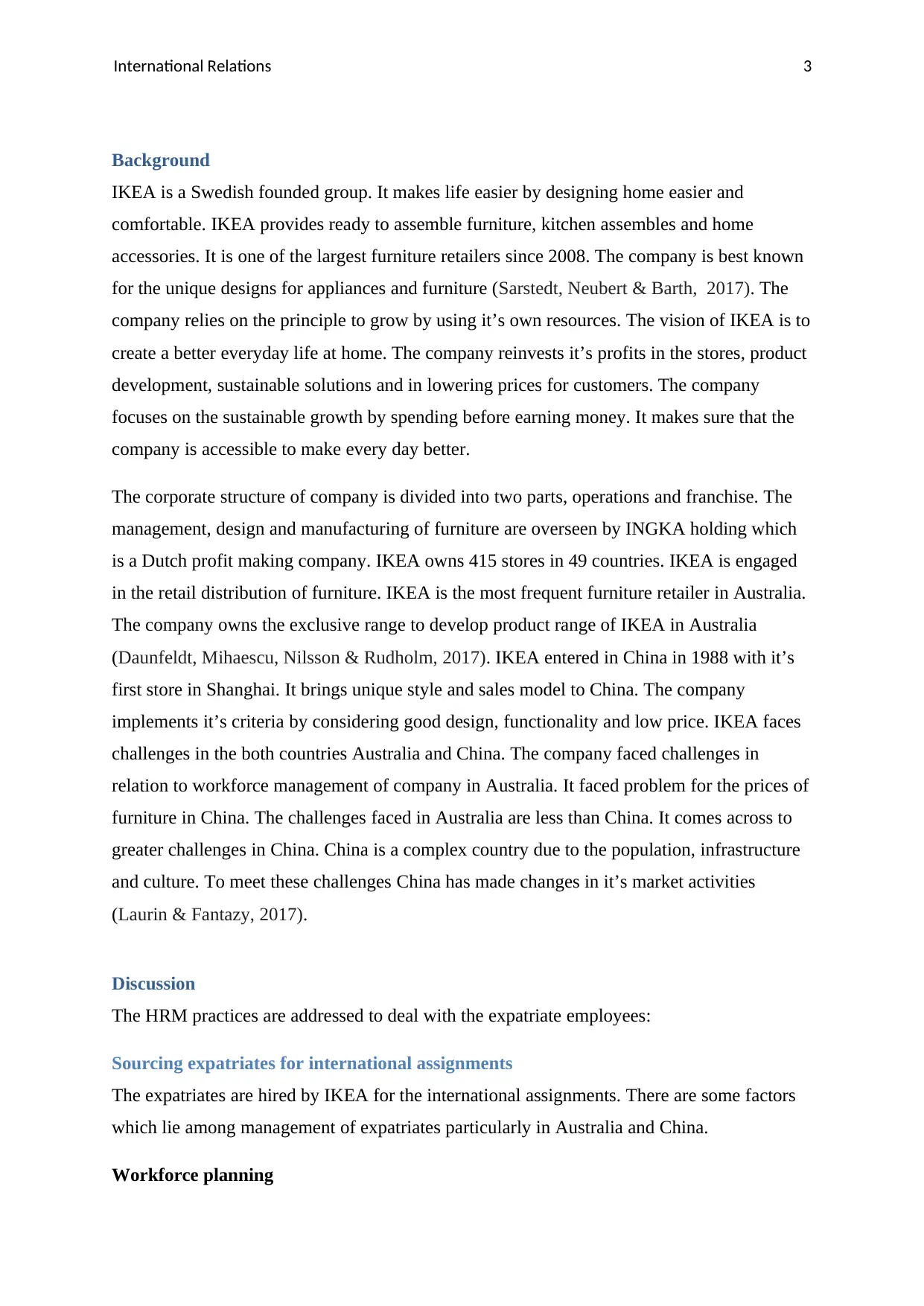
International Relations 3
Background
IKEA is a Swedish founded group. It makes life easier by designing home easier and
comfortable. IKEA provides ready to assemble furniture, kitchen assembles and home
accessories. It is one of the largest furniture retailers since 2008. The company is best known
for the unique designs for appliances and furniture (Sarstedt, Neubert & Barth, 2017). The
company relies on the principle to grow by using it’s own resources. The vision of IKEA is to
create a better everyday life at home. The company reinvests it’s profits in the stores, product
development, sustainable solutions and in lowering prices for customers. The company
focuses on the sustainable growth by spending before earning money. It makes sure that the
company is accessible to make every day better.
The corporate structure of company is divided into two parts, operations and franchise. The
management, design and manufacturing of furniture are overseen by INGKA holding which
is a Dutch profit making company. IKEA owns 415 stores in 49 countries. IKEA is engaged
in the retail distribution of furniture. IKEA is the most frequent furniture retailer in Australia.
The company owns the exclusive range to develop product range of IKEA in Australia
(Daunfeldt, Mihaescu, Nilsson & Rudholm, 2017). IKEA entered in China in 1988 with it’s
first store in Shanghai. It brings unique style and sales model to China. The company
implements it’s criteria by considering good design, functionality and low price. IKEA faces
challenges in the both countries Australia and China. The company faced challenges in
relation to workforce management of company in Australia. It faced problem for the prices of
furniture in China. The challenges faced in Australia are less than China. It comes across to
greater challenges in China. China is a complex country due to the population, infrastructure
and culture. To meet these challenges China has made changes in it’s market activities
(Laurin & Fantazy, 2017).
Discussion
The HRM practices are addressed to deal with the expatriate employees:
Sourcing expatriates for international assignments
The expatriates are hired by IKEA for the international assignments. There are some factors
which lie among management of expatriates particularly in Australia and China.
Workforce planning
Background
IKEA is a Swedish founded group. It makes life easier by designing home easier and
comfortable. IKEA provides ready to assemble furniture, kitchen assembles and home
accessories. It is one of the largest furniture retailers since 2008. The company is best known
for the unique designs for appliances and furniture (Sarstedt, Neubert & Barth, 2017). The
company relies on the principle to grow by using it’s own resources. The vision of IKEA is to
create a better everyday life at home. The company reinvests it’s profits in the stores, product
development, sustainable solutions and in lowering prices for customers. The company
focuses on the sustainable growth by spending before earning money. It makes sure that the
company is accessible to make every day better.
The corporate structure of company is divided into two parts, operations and franchise. The
management, design and manufacturing of furniture are overseen by INGKA holding which
is a Dutch profit making company. IKEA owns 415 stores in 49 countries. IKEA is engaged
in the retail distribution of furniture. IKEA is the most frequent furniture retailer in Australia.
The company owns the exclusive range to develop product range of IKEA in Australia
(Daunfeldt, Mihaescu, Nilsson & Rudholm, 2017). IKEA entered in China in 1988 with it’s
first store in Shanghai. It brings unique style and sales model to China. The company
implements it’s criteria by considering good design, functionality and low price. IKEA faces
challenges in the both countries Australia and China. The company faced challenges in
relation to workforce management of company in Australia. It faced problem for the prices of
furniture in China. The challenges faced in Australia are less than China. It comes across to
greater challenges in China. China is a complex country due to the population, infrastructure
and culture. To meet these challenges China has made changes in it’s market activities
(Laurin & Fantazy, 2017).
Discussion
The HRM practices are addressed to deal with the expatriate employees:
Sourcing expatriates for international assignments
The expatriates are hired by IKEA for the international assignments. There are some factors
which lie among management of expatriates particularly in Australia and China.
Workforce planning
Paraphrase This Document
Need a fresh take? Get an instant paraphrase of this document with our AI Paraphraser
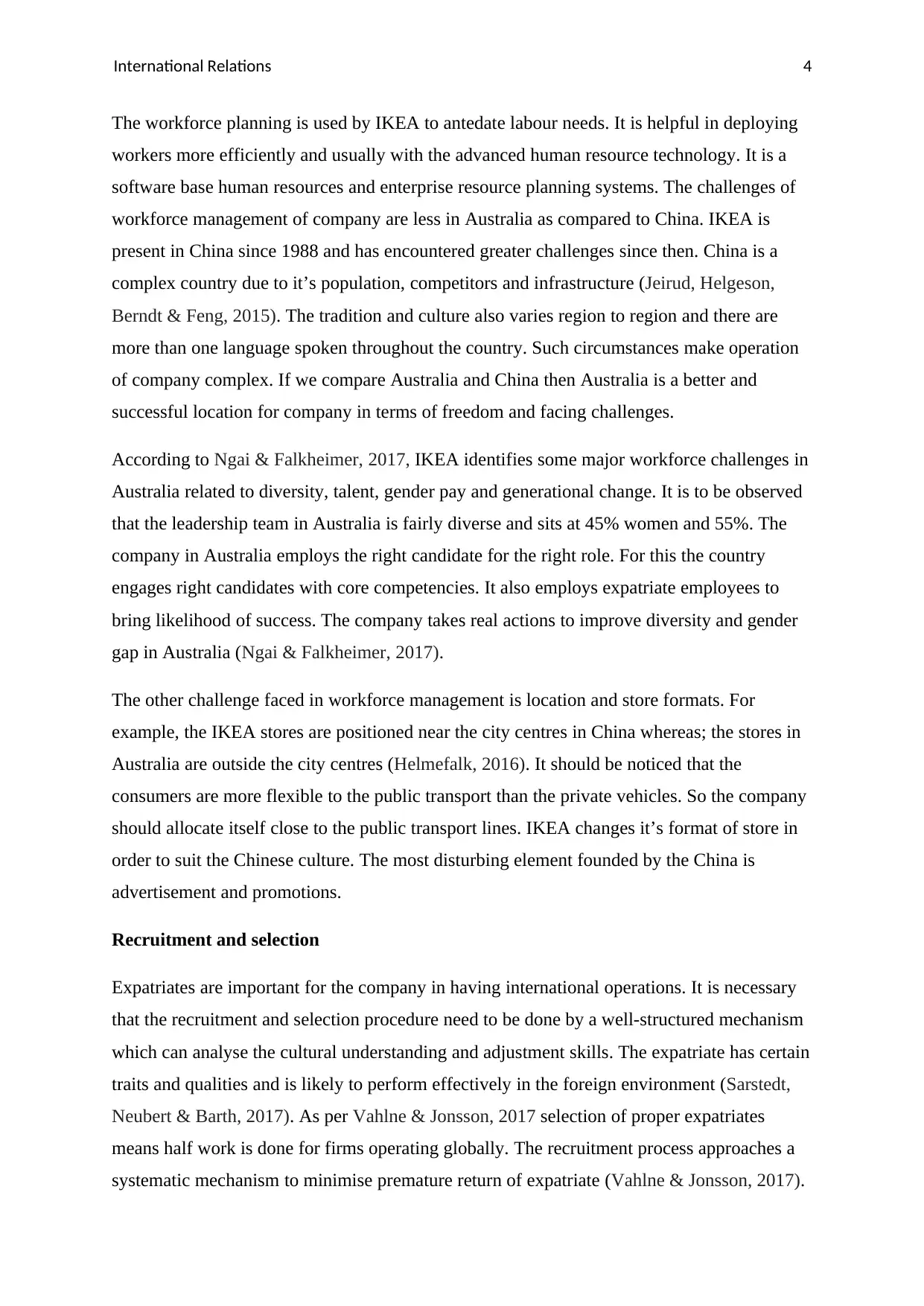
International Relations 4
The workforce planning is used by IKEA to antedate labour needs. It is helpful in deploying
workers more efficiently and usually with the advanced human resource technology. It is a
software base human resources and enterprise resource planning systems. The challenges of
workforce management of company are less in Australia as compared to China. IKEA is
present in China since 1988 and has encountered greater challenges since then. China is a
complex country due to it’s population, competitors and infrastructure (Jeirud, Helgeson,
Berndt & Feng, 2015). The tradition and culture also varies region to region and there are
more than one language spoken throughout the country. Such circumstances make operation
of company complex. If we compare Australia and China then Australia is a better and
successful location for company in terms of freedom and facing challenges.
According to Ngai & Falkheimer, 2017, IKEA identifies some major workforce challenges in
Australia related to diversity, talent, gender pay and generational change. It is to be observed
that the leadership team in Australia is fairly diverse and sits at 45% women and 55%. The
company in Australia employs the right candidate for the right role. For this the country
engages right candidates with core competencies. It also employs expatriate employees to
bring likelihood of success. The company takes real actions to improve diversity and gender
gap in Australia (Ngai & Falkheimer, 2017).
The other challenge faced in workforce management is location and store formats. For
example, the IKEA stores are positioned near the city centres in China whereas; the stores in
Australia are outside the city centres (Helmefalk, 2016). It should be noticed that the
consumers are more flexible to the public transport than the private vehicles. So the company
should allocate itself close to the public transport lines. IKEA changes it’s format of store in
order to suit the Chinese culture. The most disturbing element founded by the China is
advertisement and promotions.
Recruitment and selection
Expatriates are important for the company in having international operations. It is necessary
that the recruitment and selection procedure need to be done by a well-structured mechanism
which can analyse the cultural understanding and adjustment skills. The expatriate has certain
traits and qualities and is likely to perform effectively in the foreign environment (Sarstedt,
Neubert & Barth, 2017). As per Vahlne & Jonsson, 2017 selection of proper expatriates
means half work is done for firms operating globally. The recruitment process approaches a
systematic mechanism to minimise premature return of expatriate (Vahlne & Jonsson, 2017).
The workforce planning is used by IKEA to antedate labour needs. It is helpful in deploying
workers more efficiently and usually with the advanced human resource technology. It is a
software base human resources and enterprise resource planning systems. The challenges of
workforce management of company are less in Australia as compared to China. IKEA is
present in China since 1988 and has encountered greater challenges since then. China is a
complex country due to it’s population, competitors and infrastructure (Jeirud, Helgeson,
Berndt & Feng, 2015). The tradition and culture also varies region to region and there are
more than one language spoken throughout the country. Such circumstances make operation
of company complex. If we compare Australia and China then Australia is a better and
successful location for company in terms of freedom and facing challenges.
According to Ngai & Falkheimer, 2017, IKEA identifies some major workforce challenges in
Australia related to diversity, talent, gender pay and generational change. It is to be observed
that the leadership team in Australia is fairly diverse and sits at 45% women and 55%. The
company in Australia employs the right candidate for the right role. For this the country
engages right candidates with core competencies. It also employs expatriate employees to
bring likelihood of success. The company takes real actions to improve diversity and gender
gap in Australia (Ngai & Falkheimer, 2017).
The other challenge faced in workforce management is location and store formats. For
example, the IKEA stores are positioned near the city centres in China whereas; the stores in
Australia are outside the city centres (Helmefalk, 2016). It should be noticed that the
consumers are more flexible to the public transport than the private vehicles. So the company
should allocate itself close to the public transport lines. IKEA changes it’s format of store in
order to suit the Chinese culture. The most disturbing element founded by the China is
advertisement and promotions.
Recruitment and selection
Expatriates are important for the company in having international operations. It is necessary
that the recruitment and selection procedure need to be done by a well-structured mechanism
which can analyse the cultural understanding and adjustment skills. The expatriate has certain
traits and qualities and is likely to perform effectively in the foreign environment (Sarstedt,
Neubert & Barth, 2017). As per Vahlne & Jonsson, 2017 selection of proper expatriates
means half work is done for firms operating globally. The recruitment process approaches a
systematic mechanism to minimise premature return of expatriate (Vahlne & Jonsson, 2017).
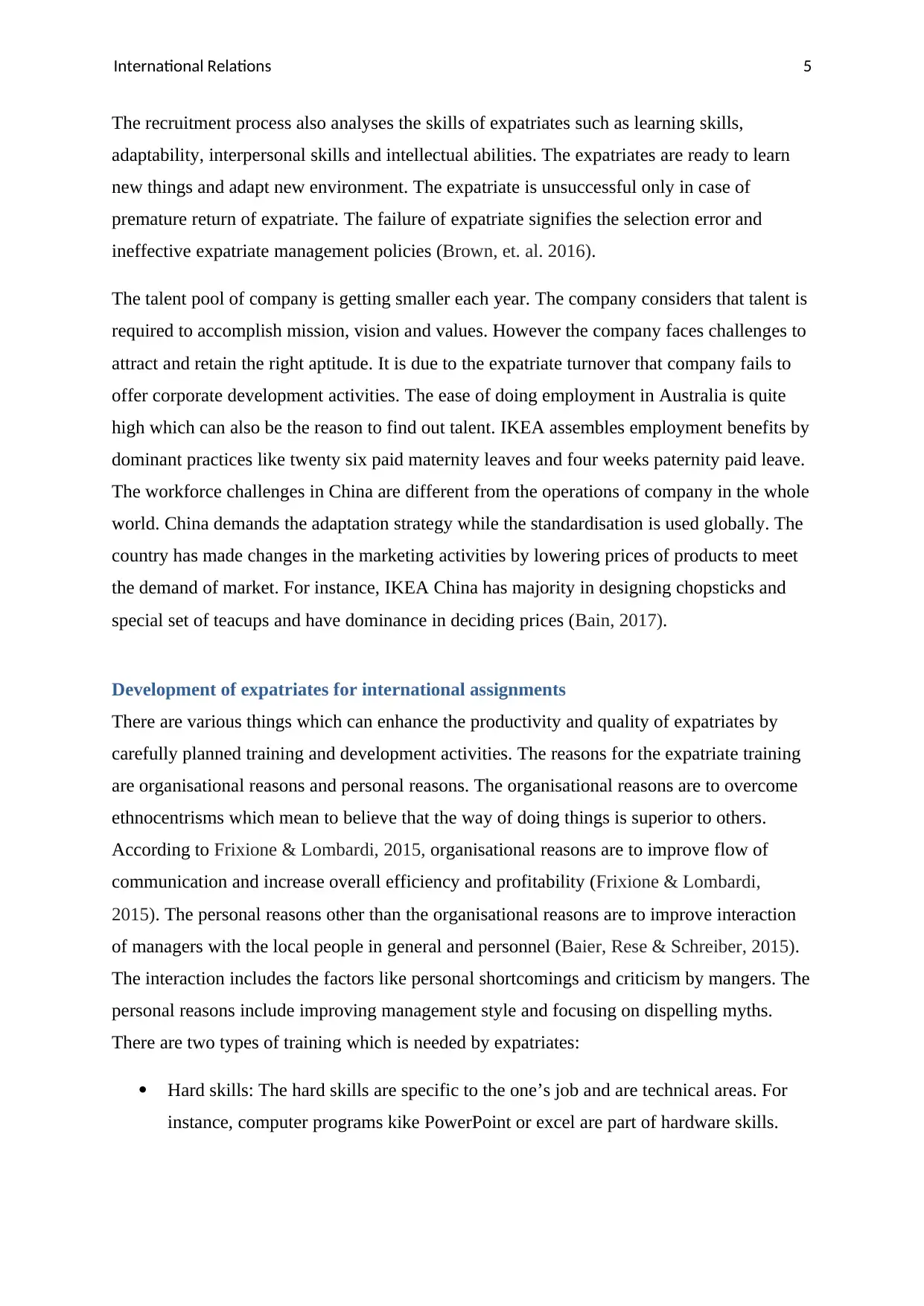
International Relations 5
The recruitment process also analyses the skills of expatriates such as learning skills,
adaptability, interpersonal skills and intellectual abilities. The expatriates are ready to learn
new things and adapt new environment. The expatriate is unsuccessful only in case of
premature return of expatriate. The failure of expatriate signifies the selection error and
ineffective expatriate management policies (Brown, et. al. 2016).
The talent pool of company is getting smaller each year. The company considers that talent is
required to accomplish mission, vision and values. However the company faces challenges to
attract and retain the right aptitude. It is due to the expatriate turnover that company fails to
offer corporate development activities. The ease of doing employment in Australia is quite
high which can also be the reason to find out talent. IKEA assembles employment benefits by
dominant practices like twenty six paid maternity leaves and four weeks paternity paid leave.
The workforce challenges in China are different from the operations of company in the whole
world. China demands the adaptation strategy while the standardisation is used globally. The
country has made changes in the marketing activities by lowering prices of products to meet
the demand of market. For instance, IKEA China has majority in designing chopsticks and
special set of teacups and have dominance in deciding prices (Bain, 2017).
Development of expatriates for international assignments
There are various things which can enhance the productivity and quality of expatriates by
carefully planned training and development activities. The reasons for the expatriate training
are organisational reasons and personal reasons. The organisational reasons are to overcome
ethnocentrisms which mean to believe that the way of doing things is superior to others.
According to Frixione & Lombardi, 2015, organisational reasons are to improve flow of
communication and increase overall efficiency and profitability (Frixione & Lombardi,
2015). The personal reasons other than the organisational reasons are to improve interaction
of managers with the local people in general and personnel (Baier, Rese & Schreiber, 2015).
The interaction includes the factors like personal shortcomings and criticism by mangers. The
personal reasons include improving management style and focusing on dispelling myths.
There are two types of training which is needed by expatriates:
Hard skills: The hard skills are specific to the one’s job and are technical areas. For
instance, computer programs kike PowerPoint or excel are part of hardware skills.
The recruitment process also analyses the skills of expatriates such as learning skills,
adaptability, interpersonal skills and intellectual abilities. The expatriates are ready to learn
new things and adapt new environment. The expatriate is unsuccessful only in case of
premature return of expatriate. The failure of expatriate signifies the selection error and
ineffective expatriate management policies (Brown, et. al. 2016).
The talent pool of company is getting smaller each year. The company considers that talent is
required to accomplish mission, vision and values. However the company faces challenges to
attract and retain the right aptitude. It is due to the expatriate turnover that company fails to
offer corporate development activities. The ease of doing employment in Australia is quite
high which can also be the reason to find out talent. IKEA assembles employment benefits by
dominant practices like twenty six paid maternity leaves and four weeks paternity paid leave.
The workforce challenges in China are different from the operations of company in the whole
world. China demands the adaptation strategy while the standardisation is used globally. The
country has made changes in the marketing activities by lowering prices of products to meet
the demand of market. For instance, IKEA China has majority in designing chopsticks and
special set of teacups and have dominance in deciding prices (Bain, 2017).
Development of expatriates for international assignments
There are various things which can enhance the productivity and quality of expatriates by
carefully planned training and development activities. The reasons for the expatriate training
are organisational reasons and personal reasons. The organisational reasons are to overcome
ethnocentrisms which mean to believe that the way of doing things is superior to others.
According to Frixione & Lombardi, 2015, organisational reasons are to improve flow of
communication and increase overall efficiency and profitability (Frixione & Lombardi,
2015). The personal reasons other than the organisational reasons are to improve interaction
of managers with the local people in general and personnel (Baier, Rese & Schreiber, 2015).
The interaction includes the factors like personal shortcomings and criticism by mangers. The
personal reasons include improving management style and focusing on dispelling myths.
There are two types of training which is needed by expatriates:
Hard skills: The hard skills are specific to the one’s job and are technical areas. For
instance, computer programs kike PowerPoint or excel are part of hardware skills.
⊘ This is a preview!⊘
Do you want full access?
Subscribe today to unlock all pages.

Trusted by 1+ million students worldwide
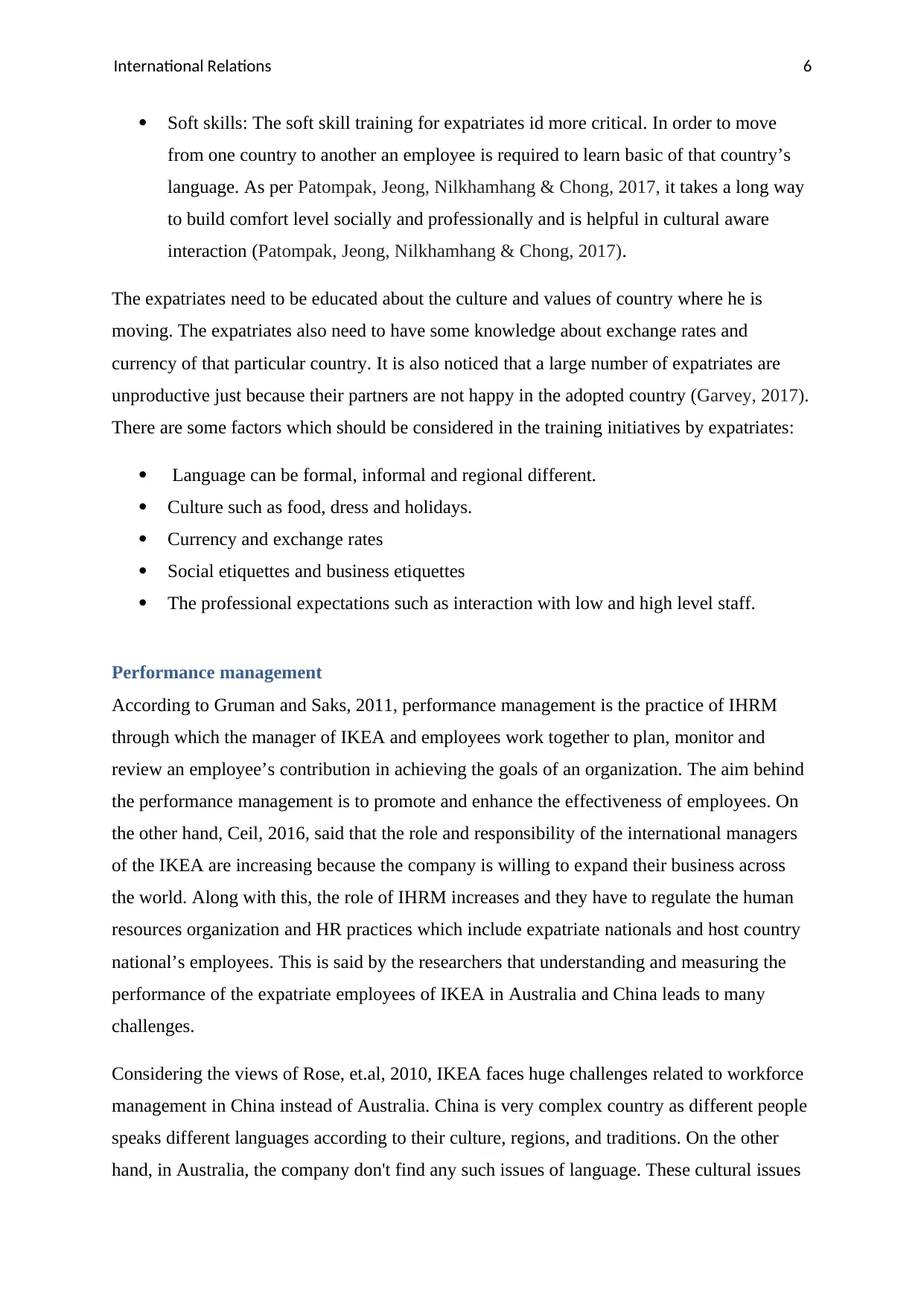
International Relations 6
Soft skills: The soft skill training for expatriates id more critical. In order to move
from one country to another an employee is required to learn basic of that country’s
language. As per Patompak, Jeong, Nilkhamhang & Chong, 2017, it takes a long way
to build comfort level socially and professionally and is helpful in cultural aware
interaction (Patompak, Jeong, Nilkhamhang & Chong, 2017).
The expatriates need to be educated about the culture and values of country where he is
moving. The expatriates also need to have some knowledge about exchange rates and
currency of that particular country. It is also noticed that a large number of expatriates are
unproductive just because their partners are not happy in the adopted country (Garvey, 2017).
There are some factors which should be considered in the training initiatives by expatriates:
Language can be formal, informal and regional different.
Culture such as food, dress and holidays.
Currency and exchange rates
Social etiquettes and business etiquettes
The professional expectations such as interaction with low and high level staff.
Performance management
According to Gruman and Saks, 2011, performance management is the practice of IHRM
through which the manager of IKEA and employees work together to plan, monitor and
review an employee’s contribution in achieving the goals of an organization. The aim behind
the performance management is to promote and enhance the effectiveness of employees. On
the other hand, Ceil, 2016, said that the role and responsibility of the international managers
of the IKEA are increasing because the company is willing to expand their business across
the world. Along with this, the role of IHRM increases and they have to regulate the human
resources organization and HR practices which include expatriate nationals and host country
national’s employees. This is said by the researchers that understanding and measuring the
performance of the expatriate employees of IKEA in Australia and China leads to many
challenges.
Considering the views of Rose, et.al, 2010, IKEA faces huge challenges related to workforce
management in China instead of Australia. China is very complex country as different people
speaks different languages according to their culture, regions, and traditions. On the other
hand, in Australia, the company don't find any such issues of language. These cultural issues
Soft skills: The soft skill training for expatriates id more critical. In order to move
from one country to another an employee is required to learn basic of that country’s
language. As per Patompak, Jeong, Nilkhamhang & Chong, 2017, it takes a long way
to build comfort level socially and professionally and is helpful in cultural aware
interaction (Patompak, Jeong, Nilkhamhang & Chong, 2017).
The expatriates need to be educated about the culture and values of country where he is
moving. The expatriates also need to have some knowledge about exchange rates and
currency of that particular country. It is also noticed that a large number of expatriates are
unproductive just because their partners are not happy in the adopted country (Garvey, 2017).
There are some factors which should be considered in the training initiatives by expatriates:
Language can be formal, informal and regional different.
Culture such as food, dress and holidays.
Currency and exchange rates
Social etiquettes and business etiquettes
The professional expectations such as interaction with low and high level staff.
Performance management
According to Gruman and Saks, 2011, performance management is the practice of IHRM
through which the manager of IKEA and employees work together to plan, monitor and
review an employee’s contribution in achieving the goals of an organization. The aim behind
the performance management is to promote and enhance the effectiveness of employees. On
the other hand, Ceil, 2016, said that the role and responsibility of the international managers
of the IKEA are increasing because the company is willing to expand their business across
the world. Along with this, the role of IHRM increases and they have to regulate the human
resources organization and HR practices which include expatriate nationals and host country
national’s employees. This is said by the researchers that understanding and measuring the
performance of the expatriate employees of IKEA in Australia and China leads to many
challenges.
Considering the views of Rose, et.al, 2010, IKEA faces huge challenges related to workforce
management in China instead of Australia. China is very complex country as different people
speaks different languages according to their culture, regions, and traditions. On the other
hand, in Australia, the company don't find any such issues of language. These cultural issues
Paraphrase This Document
Need a fresh take? Get an instant paraphrase of this document with our AI Paraphraser
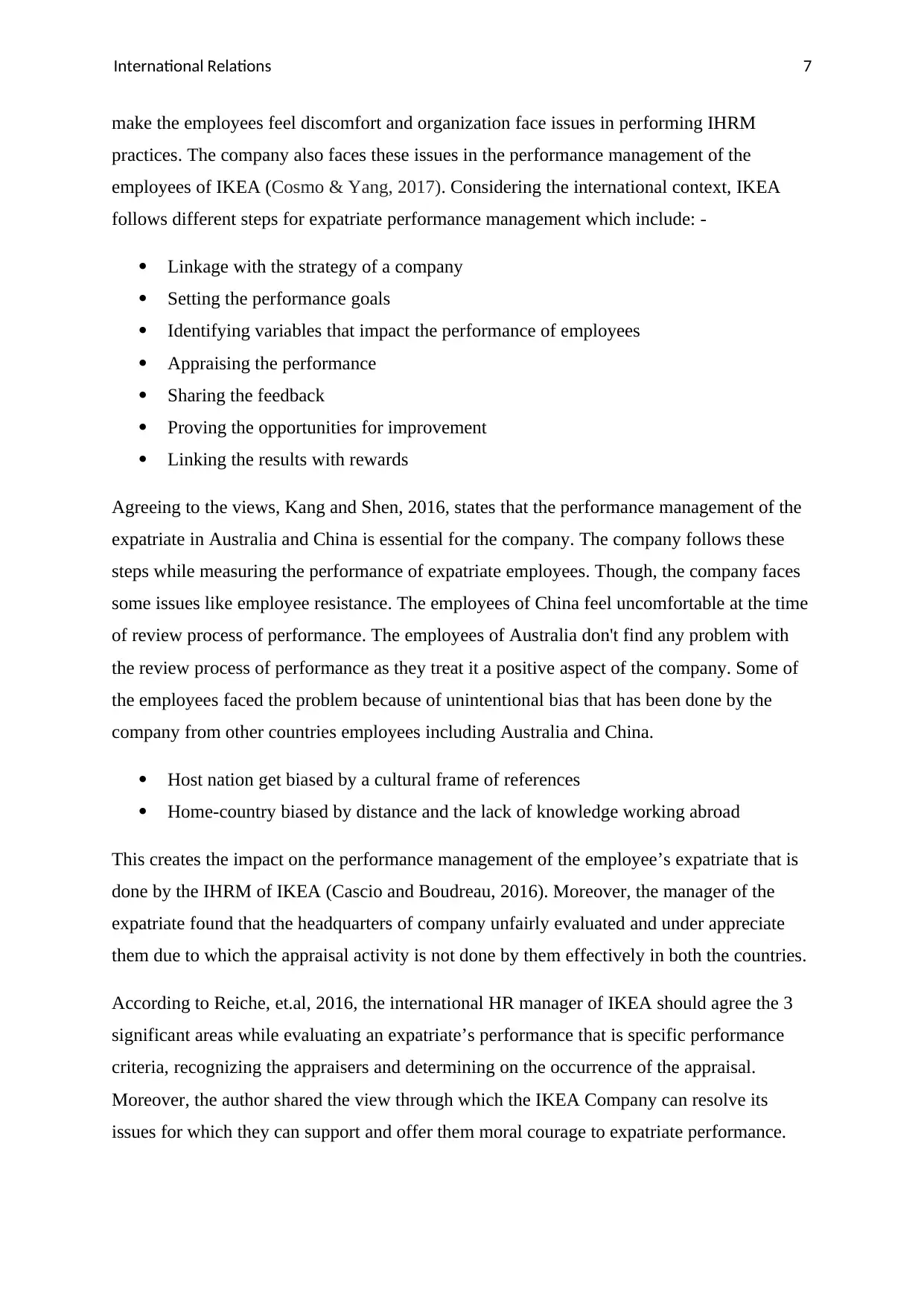
International Relations 7
make the employees feel discomfort and organization face issues in performing IHRM
practices. The company also faces these issues in the performance management of the
employees of IKEA (Cosmo & Yang, 2017). Considering the international context, IKEA
follows different steps for expatriate performance management which include: -
Linkage with the strategy of a company
Setting the performance goals
Identifying variables that impact the performance of employees
Appraising the performance
Sharing the feedback
Proving the opportunities for improvement
Linking the results with rewards
Agreeing to the views, Kang and Shen, 2016, states that the performance management of the
expatriate in Australia and China is essential for the company. The company follows these
steps while measuring the performance of expatriate employees. Though, the company faces
some issues like employee resistance. The employees of China feel uncomfortable at the time
of review process of performance. The employees of Australia don't find any problem with
the review process of performance as they treat it a positive aspect of the company. Some of
the employees faced the problem because of unintentional bias that has been done by the
company from other countries employees including Australia and China.
Host nation get biased by a cultural frame of references
Home-country biased by distance and the lack of knowledge working abroad
This creates the impact on the performance management of the employee’s expatriate that is
done by the IHRM of IKEA (Cascio and Boudreau, 2016). Moreover, the manager of the
expatriate found that the headquarters of company unfairly evaluated and under appreciate
them due to which the appraisal activity is not done by them effectively in both the countries.
According to Reiche, et.al, 2016, the international HR manager of IKEA should agree the 3
significant areas while evaluating an expatriate’s performance that is specific performance
criteria, recognizing the appraisers and determining on the occurrence of the appraisal.
Moreover, the author shared the view through which the IKEA Company can resolve its
issues for which they can support and offer them moral courage to expatriate performance.
make the employees feel discomfort and organization face issues in performing IHRM
practices. The company also faces these issues in the performance management of the
employees of IKEA (Cosmo & Yang, 2017). Considering the international context, IKEA
follows different steps for expatriate performance management which include: -
Linkage with the strategy of a company
Setting the performance goals
Identifying variables that impact the performance of employees
Appraising the performance
Sharing the feedback
Proving the opportunities for improvement
Linking the results with rewards
Agreeing to the views, Kang and Shen, 2016, states that the performance management of the
expatriate in Australia and China is essential for the company. The company follows these
steps while measuring the performance of expatriate employees. Though, the company faces
some issues like employee resistance. The employees of China feel uncomfortable at the time
of review process of performance. The employees of Australia don't find any problem with
the review process of performance as they treat it a positive aspect of the company. Some of
the employees faced the problem because of unintentional bias that has been done by the
company from other countries employees including Australia and China.
Host nation get biased by a cultural frame of references
Home-country biased by distance and the lack of knowledge working abroad
This creates the impact on the performance management of the employee’s expatriate that is
done by the IHRM of IKEA (Cascio and Boudreau, 2016). Moreover, the manager of the
expatriate found that the headquarters of company unfairly evaluated and under appreciate
them due to which the appraisal activity is not done by them effectively in both the countries.
According to Reiche, et.al, 2016, the international HR manager of IKEA should agree the 3
significant areas while evaluating an expatriate’s performance that is specific performance
criteria, recognizing the appraisers and determining on the occurrence of the appraisal.
Moreover, the author shared the view through which the IKEA Company can resolve its
issues for which they can support and offer them moral courage to expatriate performance.
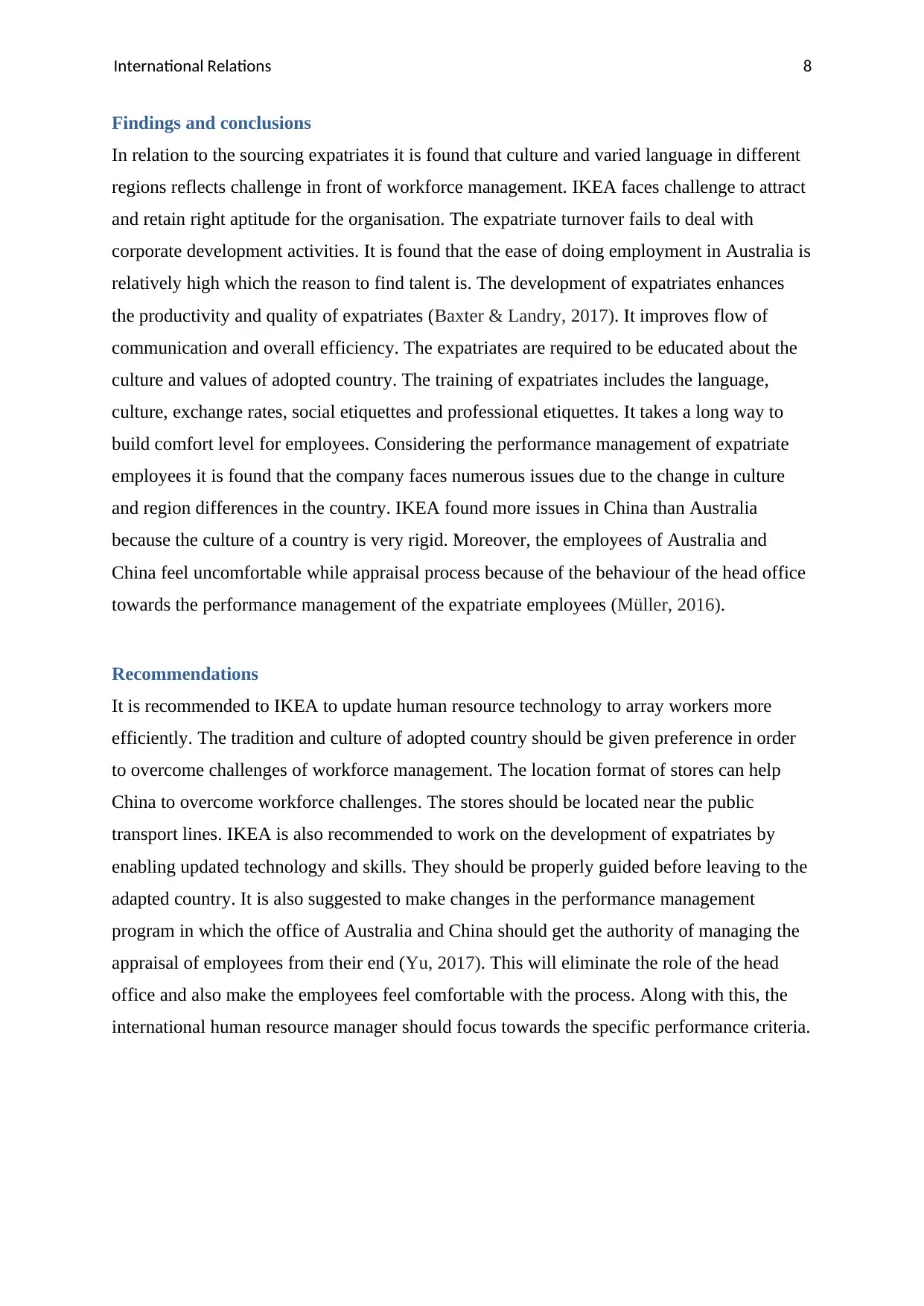
International Relations 8
Findings and conclusions
In relation to the sourcing expatriates it is found that culture and varied language in different
regions reflects challenge in front of workforce management. IKEA faces challenge to attract
and retain right aptitude for the organisation. The expatriate turnover fails to deal with
corporate development activities. It is found that the ease of doing employment in Australia is
relatively high which the reason to find talent is. The development of expatriates enhances
the productivity and quality of expatriates (Baxter & Landry, 2017). It improves flow of
communication and overall efficiency. The expatriates are required to be educated about the
culture and values of adopted country. The training of expatriates includes the language,
culture, exchange rates, social etiquettes and professional etiquettes. It takes a long way to
build comfort level for employees. Considering the performance management of expatriate
employees it is found that the company faces numerous issues due to the change in culture
and region differences in the country. IKEA found more issues in China than Australia
because the culture of a country is very rigid. Moreover, the employees of Australia and
China feel uncomfortable while appraisal process because of the behaviour of the head office
towards the performance management of the expatriate employees (Müller, 2016).
Recommendations
It is recommended to IKEA to update human resource technology to array workers more
efficiently. The tradition and culture of adopted country should be given preference in order
to overcome challenges of workforce management. The location format of stores can help
China to overcome workforce challenges. The stores should be located near the public
transport lines. IKEA is also recommended to work on the development of expatriates by
enabling updated technology and skills. They should be properly guided before leaving to the
adapted country. It is also suggested to make changes in the performance management
program in which the office of Australia and China should get the authority of managing the
appraisal of employees from their end (Yu, 2017). This will eliminate the role of the head
office and also make the employees feel comfortable with the process. Along with this, the
international human resource manager should focus towards the specific performance criteria.
Findings and conclusions
In relation to the sourcing expatriates it is found that culture and varied language in different
regions reflects challenge in front of workforce management. IKEA faces challenge to attract
and retain right aptitude for the organisation. The expatriate turnover fails to deal with
corporate development activities. It is found that the ease of doing employment in Australia is
relatively high which the reason to find talent is. The development of expatriates enhances
the productivity and quality of expatriates (Baxter & Landry, 2017). It improves flow of
communication and overall efficiency. The expatriates are required to be educated about the
culture and values of adopted country. The training of expatriates includes the language,
culture, exchange rates, social etiquettes and professional etiquettes. It takes a long way to
build comfort level for employees. Considering the performance management of expatriate
employees it is found that the company faces numerous issues due to the change in culture
and region differences in the country. IKEA found more issues in China than Australia
because the culture of a country is very rigid. Moreover, the employees of Australia and
China feel uncomfortable while appraisal process because of the behaviour of the head office
towards the performance management of the expatriate employees (Müller, 2016).
Recommendations
It is recommended to IKEA to update human resource technology to array workers more
efficiently. The tradition and culture of adopted country should be given preference in order
to overcome challenges of workforce management. The location format of stores can help
China to overcome workforce challenges. The stores should be located near the public
transport lines. IKEA is also recommended to work on the development of expatriates by
enabling updated technology and skills. They should be properly guided before leaving to the
adapted country. It is also suggested to make changes in the performance management
program in which the office of Australia and China should get the authority of managing the
appraisal of employees from their end (Yu, 2017). This will eliminate the role of the head
office and also make the employees feel comfortable with the process. Along with this, the
international human resource manager should focus towards the specific performance criteria.
⊘ This is a preview!⊘
Do you want full access?
Subscribe today to unlock all pages.

Trusted by 1+ million students worldwide
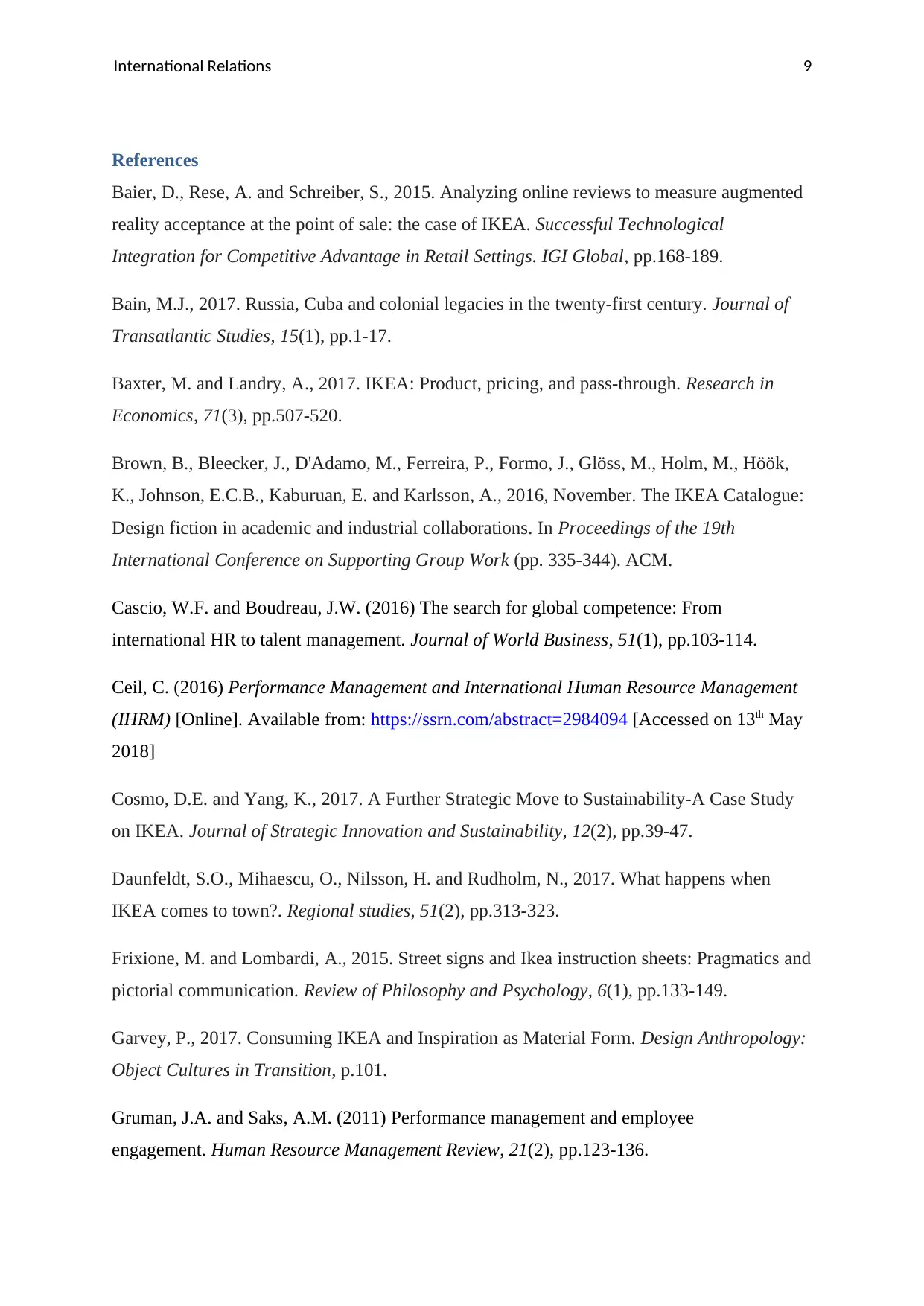
International Relations 9
References
Baier, D., Rese, A. and Schreiber, S., 2015. Analyzing online reviews to measure augmented
reality acceptance at the point of sale: the case of IKEA. Successful Technological
Integration for Competitive Advantage in Retail Settings. IGI Global, pp.168-189.
Bain, M.J., 2017. Russia, Cuba and colonial legacies in the twenty-first century. Journal of
Transatlantic Studies, 15(1), pp.1-17.
Baxter, M. and Landry, A., 2017. IKEA: Product, pricing, and pass-through. Research in
Economics, 71(3), pp.507-520.
Brown, B., Bleecker, J., D'Adamo, M., Ferreira, P., Formo, J., Glöss, M., Holm, M., Höök,
K., Johnson, E.C.B., Kaburuan, E. and Karlsson, A., 2016, November. The IKEA Catalogue:
Design fiction in academic and industrial collaborations. In Proceedings of the 19th
International Conference on Supporting Group Work (pp. 335-344). ACM.
Cascio, W.F. and Boudreau, J.W. (2016) The search for global competence: From
international HR to talent management. Journal of World Business, 51(1), pp.103-114.
Ceil, C. (2016) Performance Management and International Human Resource Management
(IHRM) [Online]. Available from: https://ssrn.com/abstract=2984094 [Accessed on 13th May
2018]
Cosmo, D.E. and Yang, K., 2017. A Further Strategic Move to Sustainability-A Case Study
on IKEA. Journal of Strategic Innovation and Sustainability, 12(2), pp.39-47.
Daunfeldt, S.O., Mihaescu, O., Nilsson, H. and Rudholm, N., 2017. What happens when
IKEA comes to town?. Regional studies, 51(2), pp.313-323.
Frixione, M. and Lombardi, A., 2015. Street signs and Ikea instruction sheets: Pragmatics and
pictorial communication. Review of Philosophy and Psychology, 6(1), pp.133-149.
Garvey, P., 2017. Consuming IKEA and Inspiration as Material Form. Design Anthropology:
Object Cultures in Transition, p.101.
Gruman, J.A. and Saks, A.M. (2011) Performance management and employee
engagement. Human Resource Management Review, 21(2), pp.123-136.
References
Baier, D., Rese, A. and Schreiber, S., 2015. Analyzing online reviews to measure augmented
reality acceptance at the point of sale: the case of IKEA. Successful Technological
Integration for Competitive Advantage in Retail Settings. IGI Global, pp.168-189.
Bain, M.J., 2017. Russia, Cuba and colonial legacies in the twenty-first century. Journal of
Transatlantic Studies, 15(1), pp.1-17.
Baxter, M. and Landry, A., 2017. IKEA: Product, pricing, and pass-through. Research in
Economics, 71(3), pp.507-520.
Brown, B., Bleecker, J., D'Adamo, M., Ferreira, P., Formo, J., Glöss, M., Holm, M., Höök,
K., Johnson, E.C.B., Kaburuan, E. and Karlsson, A., 2016, November. The IKEA Catalogue:
Design fiction in academic and industrial collaborations. In Proceedings of the 19th
International Conference on Supporting Group Work (pp. 335-344). ACM.
Cascio, W.F. and Boudreau, J.W. (2016) The search for global competence: From
international HR to talent management. Journal of World Business, 51(1), pp.103-114.
Ceil, C. (2016) Performance Management and International Human Resource Management
(IHRM) [Online]. Available from: https://ssrn.com/abstract=2984094 [Accessed on 13th May
2018]
Cosmo, D.E. and Yang, K., 2017. A Further Strategic Move to Sustainability-A Case Study
on IKEA. Journal of Strategic Innovation and Sustainability, 12(2), pp.39-47.
Daunfeldt, S.O., Mihaescu, O., Nilsson, H. and Rudholm, N., 2017. What happens when
IKEA comes to town?. Regional studies, 51(2), pp.313-323.
Frixione, M. and Lombardi, A., 2015. Street signs and Ikea instruction sheets: Pragmatics and
pictorial communication. Review of Philosophy and Psychology, 6(1), pp.133-149.
Garvey, P., 2017. Consuming IKEA and Inspiration as Material Form. Design Anthropology:
Object Cultures in Transition, p.101.
Gruman, J.A. and Saks, A.M. (2011) Performance management and employee
engagement. Human Resource Management Review, 21(2), pp.123-136.
Paraphrase This Document
Need a fresh take? Get an instant paraphrase of this document with our AI Paraphraser
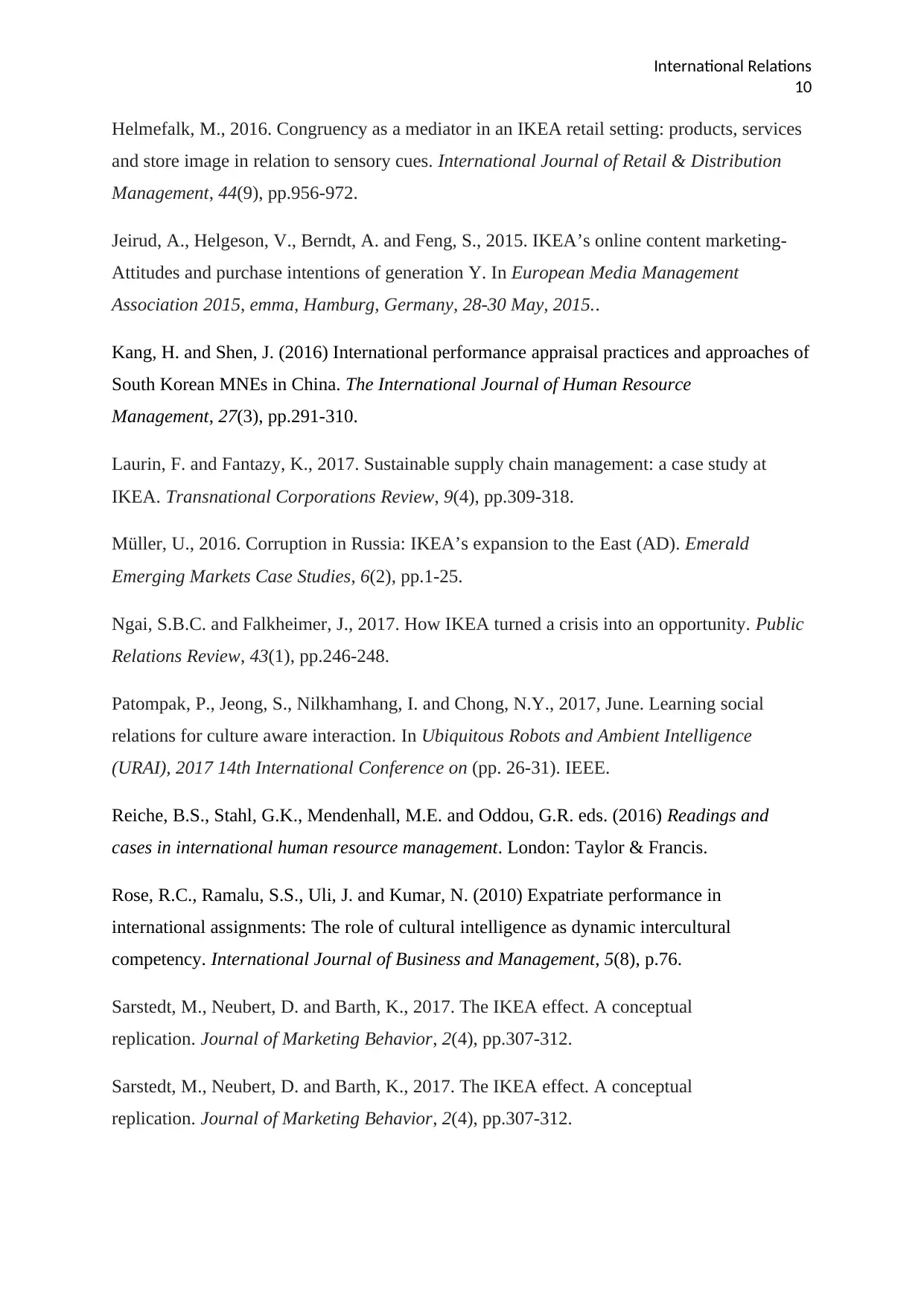
International Relations
10
Helmefalk, M., 2016. Congruency as a mediator in an IKEA retail setting: products, services
and store image in relation to sensory cues. International Journal of Retail & Distribution
Management, 44(9), pp.956-972.
Jeirud, A., Helgeson, V., Berndt, A. and Feng, S., 2015. IKEA’s online content marketing-
Attitudes and purchase intentions of generation Y. In European Media Management
Association 2015, emma, Hamburg, Germany, 28-30 May, 2015..
Kang, H. and Shen, J. (2016) International performance appraisal practices and approaches of
South Korean MNEs in China. The International Journal of Human Resource
Management, 27(3), pp.291-310.
Laurin, F. and Fantazy, K., 2017. Sustainable supply chain management: a case study at
IKEA. Transnational Corporations Review, 9(4), pp.309-318.
Müller, U., 2016. Corruption in Russia: IKEA’s expansion to the East (AD). Emerald
Emerging Markets Case Studies, 6(2), pp.1-25.
Ngai, S.B.C. and Falkheimer, J., 2017. How IKEA turned a crisis into an opportunity. Public
Relations Review, 43(1), pp.246-248.
Patompak, P., Jeong, S., Nilkhamhang, I. and Chong, N.Y., 2017, June. Learning social
relations for culture aware interaction. In Ubiquitous Robots and Ambient Intelligence
(URAI), 2017 14th International Conference on (pp. 26-31). IEEE.
Reiche, B.S., Stahl, G.K., Mendenhall, M.E. and Oddou, G.R. eds. (2016) Readings and
cases in international human resource management. London: Taylor & Francis.
Rose, R.C., Ramalu, S.S., Uli, J. and Kumar, N. (2010) Expatriate performance in
international assignments: The role of cultural intelligence as dynamic intercultural
competency. International Journal of Business and Management, 5(8), p.76.
Sarstedt, M., Neubert, D. and Barth, K., 2017. The IKEA effect. A conceptual
replication. Journal of Marketing Behavior, 2(4), pp.307-312.
Sarstedt, M., Neubert, D. and Barth, K., 2017. The IKEA effect. A conceptual
replication. Journal of Marketing Behavior, 2(4), pp.307-312.
10
Helmefalk, M., 2016. Congruency as a mediator in an IKEA retail setting: products, services
and store image in relation to sensory cues. International Journal of Retail & Distribution
Management, 44(9), pp.956-972.
Jeirud, A., Helgeson, V., Berndt, A. and Feng, S., 2015. IKEA’s online content marketing-
Attitudes and purchase intentions of generation Y. In European Media Management
Association 2015, emma, Hamburg, Germany, 28-30 May, 2015..
Kang, H. and Shen, J. (2016) International performance appraisal practices and approaches of
South Korean MNEs in China. The International Journal of Human Resource
Management, 27(3), pp.291-310.
Laurin, F. and Fantazy, K., 2017. Sustainable supply chain management: a case study at
IKEA. Transnational Corporations Review, 9(4), pp.309-318.
Müller, U., 2016. Corruption in Russia: IKEA’s expansion to the East (AD). Emerald
Emerging Markets Case Studies, 6(2), pp.1-25.
Ngai, S.B.C. and Falkheimer, J., 2017. How IKEA turned a crisis into an opportunity. Public
Relations Review, 43(1), pp.246-248.
Patompak, P., Jeong, S., Nilkhamhang, I. and Chong, N.Y., 2017, June. Learning social
relations for culture aware interaction. In Ubiquitous Robots and Ambient Intelligence
(URAI), 2017 14th International Conference on (pp. 26-31). IEEE.
Reiche, B.S., Stahl, G.K., Mendenhall, M.E. and Oddou, G.R. eds. (2016) Readings and
cases in international human resource management. London: Taylor & Francis.
Rose, R.C., Ramalu, S.S., Uli, J. and Kumar, N. (2010) Expatriate performance in
international assignments: The role of cultural intelligence as dynamic intercultural
competency. International Journal of Business and Management, 5(8), p.76.
Sarstedt, M., Neubert, D. and Barth, K., 2017. The IKEA effect. A conceptual
replication. Journal of Marketing Behavior, 2(4), pp.307-312.
Sarstedt, M., Neubert, D. and Barth, K., 2017. The IKEA effect. A conceptual
replication. Journal of Marketing Behavior, 2(4), pp.307-312.
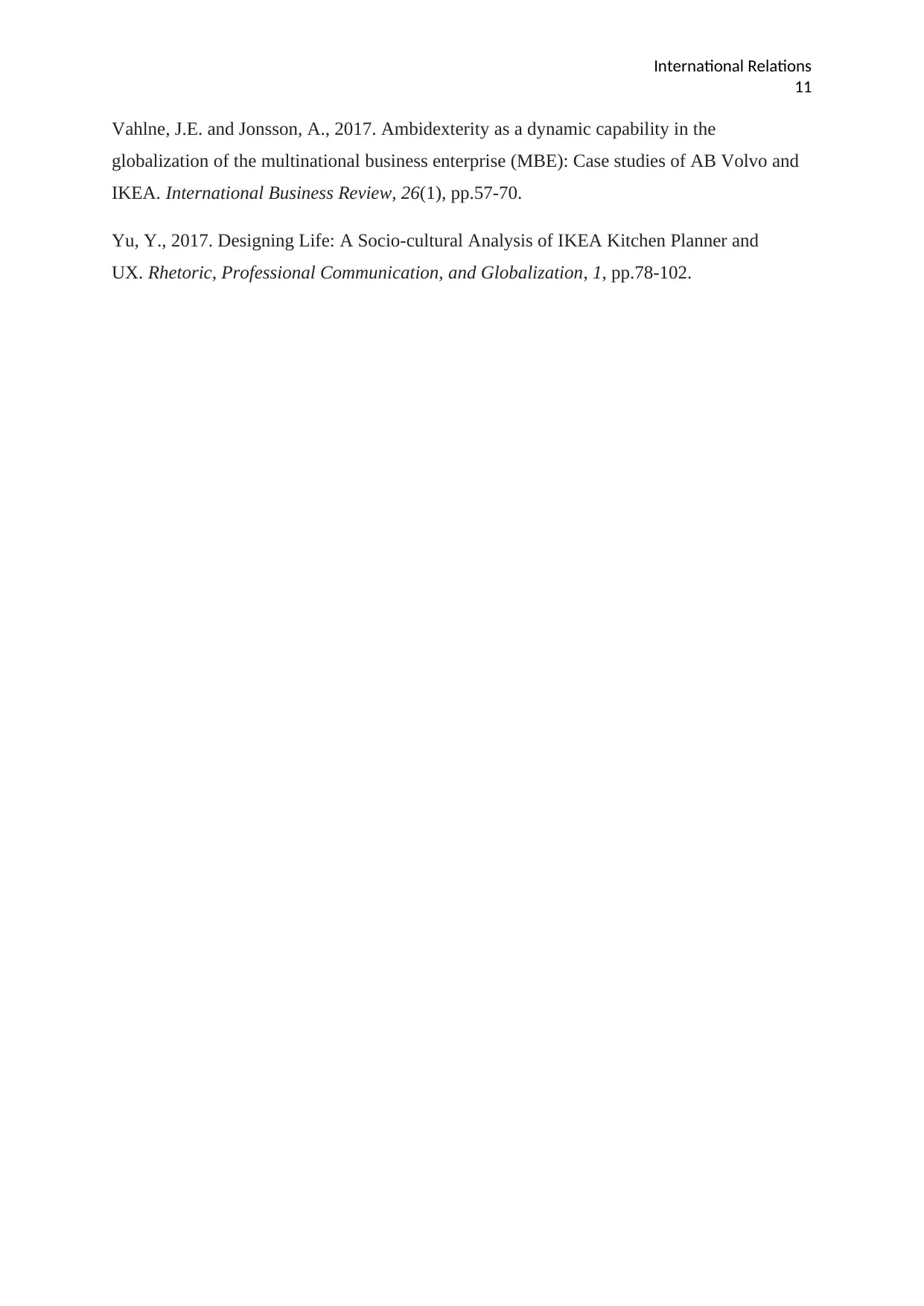
International Relations
11
Vahlne, J.E. and Jonsson, A., 2017. Ambidexterity as a dynamic capability in the
globalization of the multinational business enterprise (MBE): Case studies of AB Volvo and
IKEA. International Business Review, 26(1), pp.57-70.
Yu, Y., 2017. Designing Life: A Socio-cultural Analysis of IKEA Kitchen Planner and
UX. Rhetoric, Professional Communication, and Globalization, 1, pp.78-102.
11
Vahlne, J.E. and Jonsson, A., 2017. Ambidexterity as a dynamic capability in the
globalization of the multinational business enterprise (MBE): Case studies of AB Volvo and
IKEA. International Business Review, 26(1), pp.57-70.
Yu, Y., 2017. Designing Life: A Socio-cultural Analysis of IKEA Kitchen Planner and
UX. Rhetoric, Professional Communication, and Globalization, 1, pp.78-102.
⊘ This is a preview!⊘
Do you want full access?
Subscribe today to unlock all pages.

Trusted by 1+ million students worldwide
1 out of 12
Related Documents
Your All-in-One AI-Powered Toolkit for Academic Success.
+13062052269
info@desklib.com
Available 24*7 on WhatsApp / Email
![[object Object]](/_next/static/media/star-bottom.7253800d.svg)
Unlock your academic potential
Copyright © 2020–2025 A2Z Services. All Rights Reserved. Developed and managed by ZUCOL.




